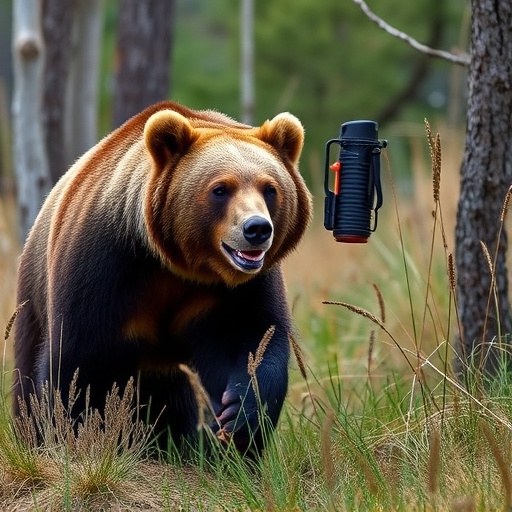Understanding bear behavior is key for hikers. Bear spray is necessary in close proximity to bears, especially mothers with cubs or felt threats. Use spray correctly by appearing larger, talking loudly, and backing away slowly. Choose products with capsaicin or peppermint oil, proper concentration, and frequent usage. Target the face and chest of an approaching bear with quick 2-3 second bursts from a safe distance. Store bear spray securely in original packaging, protecting it from extreme temps. Follow local regulations and guidelines for optimal protection in bear country.
“As hikers, venturing into wild territories, understanding our surroundings is paramount. Among the potential hazards, bears pose a significant challenge. This guide explores the necessity of bear repellent spray for your hiking trips. We delve into the science behind bear behavior to determine when such spray is crucial. Learn about selecting the right product and application techniques for maximum effectiveness. Additionally, we cover legal aspects and storage tips for ensuring safety and compliance.”
- Understanding Bear Behavior: When is Spray Necessary?
- Choosing the Right Bear Repellent Spray
- Application Technique: Ensuring Maximum Effectiveness
- Legal Considerations and Storage Tips
Understanding Bear Behavior: When is Spray Necessary?
Understanding bear behavior is key to determining when bear repellent spray is a necessity for hikers and outdoor enthusiasts. Bears are generally wary of humans, but certain situations can trigger aggressive responses. For instance, mothers with cubs will defend their young aggressively, and bears may become defensive if they feel threatened or surprised. They have a strong sense of smell, so they often detect people from a distance, allowing them to avoid potential conflicts.
The need for bear spray arises when proximity to bears increases the risk of an attack. This typically happens in areas where food sources are scarce, such as late summer or early fall, as bears seek out easier meals. If you encounter a bear unexpectedly on the trail, remain calm and assess the situation. In most cases, making yourself appear larger, talking loudly, and slowly backing away can deter a bear from approaching further. However, if the bear shows no signs of leaving or becomes more aggressive, it’s time to use bear spray properly: at close range, directly into the bear’s face, to create a barrier between you and the animal.
Choosing the Right Bear Repellent Spray
When selecting a bear repellent spray, it’s crucial to consider factors like active ingredients, concentration, and usage frequency. Opt for products containing proven irritants such as capsaicin or peppermint oil, which have shown effectiveness in deterring bears. Check the spray’s label for recommended distances and usage instructions; proper application is key to its success.
Always choose a spray designed specifically for outdoor activities like hiking or camping, ensuring it meets industry standards for bear deterrents. Store your bear spray in an accessible yet secure location on your body or gear, and familiarize yourself with its operation before heading into potential bear country. Remember that regular maintenance and replacement are vital to ensure the spray remains effective over time.
Application Technique: Ensuring Maximum Effectiveness
Proper application is key to maximizing the effectiveness of bear repellent spray. It’s essential to understand that bear spray works best as a deterrent, creating an unpleasant experience for potential bears rather than instantly neutralizing them. When using bear spray during a hike, always aim for the face and chest area of the approaching bear. This is because these areas are most sensitive to the spray’s irritants, triggering a reaction that encourages the bear to flee.
Follow these steps for optimal results: (1) Stand your ground and assess the bear’s behavior; (2) never turn your back on the bear; (3) use quick, short bursts of spray—about 2-3 seconds—from a safe distance, typically around 20-30 feet; (4) move away slowly while the bear is distracted by the spray. Remember, the goal is to deter an aggressive encounter rather than physically stop a bear, so proper timing and application are crucial for your safety in the wilderness.
Legal Considerations and Storage Tips
When it comes to hiking in areas known for bear populations, understanding legal considerations and proper storage is crucial. Always check local regulations regarding the use and carrying of bear repellent spray, as restrictions vary by region. Some parks or wilderness areas may have specific guidelines on types, amounts, and where these can be stored. Adhering to these rules not only ensures you’re using the right products but also protects you from fines or other penalties.
For optimal effectiveness and safety, store bear spray appropriately. Keep it in its original packaging, out of reach of children and pets. Avoid leaving it in hot or cold extremes; extreme temperatures can diminish its potency. Securely lock it up in your car or backpack while hiking, ensuring it remains intact and ready for use when needed. Remember, proper storage is key to ensuring you have the protection you need during your hike—When to Use Bear Spray Properly should always guide your actions.
In conclusion, while understanding bear behavior is crucial for safe hiking, knowing when to use bear spray properly is equally vital. By choosing the right repellent, applying it correctly, and being aware of legalities and storage, hikers can effectively protect themselves in bear country. Remember, prevention through awareness and proper usage of bear spray is key to minimizing encounters and ensuring a safe outdoor experience.
